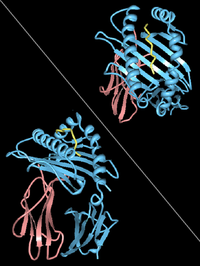
Photo from wikipedia
NK cells change their phenotype and functional characteristics during activation. In this work, we searched for a relationship of HLA‐DR expression with differentiation stages and functional activity of NK cells… Click to show full abstract
NK cells change their phenotype and functional characteristics during activation. In this work, we searched for a relationship of HLA‐DR expression with differentiation stages and functional activity of NK cells ex vivo and stimulated in vitro with IL‐2 challenged with gene modified feeder K562 cells expressing membrane‐bound IL‐21 (K562‐mbIL21). This stimulation technique has been described for NK cell expansion in clinical use. We have observed that HLA‐DR expression in freshly isolated circulating NK cells was mostly associated with less differentiated CD56brightCD57– cells, although in some individuals it could also be found in terminally differentiated CD57+ cells. Ex vivo HLA‐DR+ NK cells possessed better capacity to produce IFN‐γ in response to cytokine stimulation compared to their HLA‐DR– counterparts. In vitro activation with IL‐2 and K562‐mbIL21 induces an increase in HLA‐DR‐positive NK cell proportion, again mostly among CD56brightCD57– NK cells. This happened in particular due to appearance of HLA‐DR+ expression de novo in HLA‐DR‐negative cells. Acquired in vitro HLA‐DR expression was associated with NK cell proliferation activity, more intense cytokine‐induced IFN‐γ production, increased degranulation toward feeder cells, and higher expression of CD86 and NKG2D. Thus, stimulation with IL‐2/K562‐mbIL21 causes a significant phenotype and functional shift during NK cell activation and expansion.
Journal Title: Immunology and Cell Biology
Year Published: 2018
Link to full text (if available)
Share on Social Media: Sign Up to like & get
recommendations!